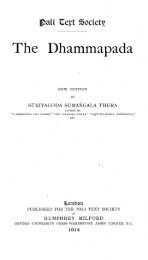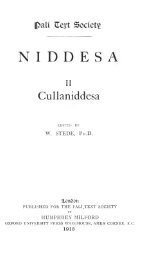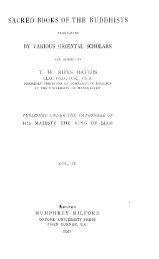Lessons In Practical Buddhism - Sirimangalo.Org
Lessons In Practical Buddhism - Sirimangalo.Org
Lessons In Practical Buddhism - Sirimangalo.Org
Create successful ePaper yourself
Turn your PDF publications into a flip-book with our unique Google optimized e-Paper software.
“idha bhikkhu cakkhunā rūpaṃ disvā na nimittaggāhī hoti<br />
nānubyañjanaggāhī.”<br />
“Here, a bhikkhu, having seen a form with the eye, is<br />
neither one who takes hold of the characteristics nor one<br />
who takes hold of the details.”<br />
Still, for someone who is used to grasping at characteristics<br />
and details – those very things that give rise to likes and<br />
dislikes, identification and possessiveness – it can be a<br />
disturbing realization that reality admits of no such<br />
particulars, that our attachments to these things are based<br />
on that which does not even exist.<br />
Truly, what one sees in the mirror is just light. It is only after<br />
the light touches the eye that the mind processes the image<br />
and discerns, “this is me,” or even, “this is a person.” For a<br />
meditator, because of their ability to concentrate on the<br />
seeing just as it is, such recognition may not occur at all.<br />
Whereas for an ordinary person much extrapolation will<br />
occur based on the experience of seeing – first they<br />
recognize it, then they like it or dislike it, judging one’s<br />
image as beautiful, ugly, good or bad. The ordinary mind<br />
moves very quickly and without training will tend to move at<br />
random like a person in a dark room, bumping into the<br />
various objects that it meets with, and suffering accordingly.<br />
Once one practices meditation and focuses the mind on the<br />
reality of each experience, seeing becomes simply light<br />
touching the eye, a reality that arises and ceases. The idea<br />
that there is an external object, a person inside the mirror for<br />
example, vanishes. When one looks in a mirror, one projects<br />
the idea of a person inside the mirror, even though one is<br />
clearly aware that there is no such person inside the glass.<br />
There is thus no reason to feel concern towards this sort of<br />
experience. When some meditators return home to their<br />
families after meditation courses, their families become quite<br />
upset when they see that their children are no longer<br />
attached to them, no longer cling to them, and they will<br />
become quite upset as a result. As a result, even the<br />
meditator, if their practice has not progressed far enough,<br />
may be convinced that the meditation has caused suffering<br />
104












